Day 2 of a long weekend of tours today and it was off down to the Broads.
We started out looking for the herd of wild swans which has been wintering in the Ludham area. The swans have not been out on the old airfield so much recently, so we made for the levels first. On the way, we could see a small group of what from a distance looked like Whooper Swans out on the fields, but decided we would look for the large mixed group. However, they were not where they should have been! We headed back and had a good look at the 20 Whooper Swans. They were in a ploughed former beet field, where the larger herd had been feeding a few weeks ago, but looked nervous and there was obviously little food left there for them. While we were watching, they flew off towards the levels, calling loudly.
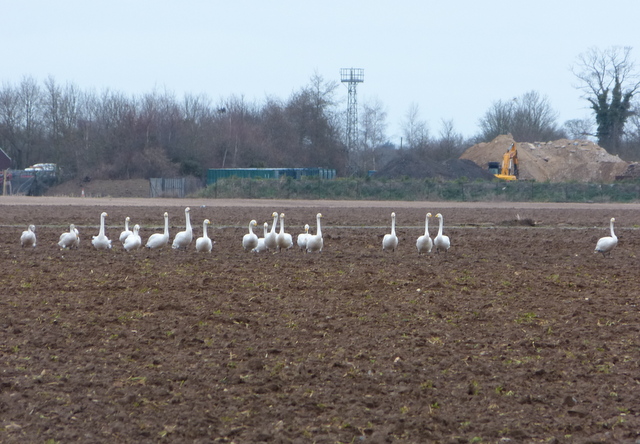 Whooper Swans – 20 looking lost in a ploughed field
Whooper Swans – 20 looking lost in a ploughed field
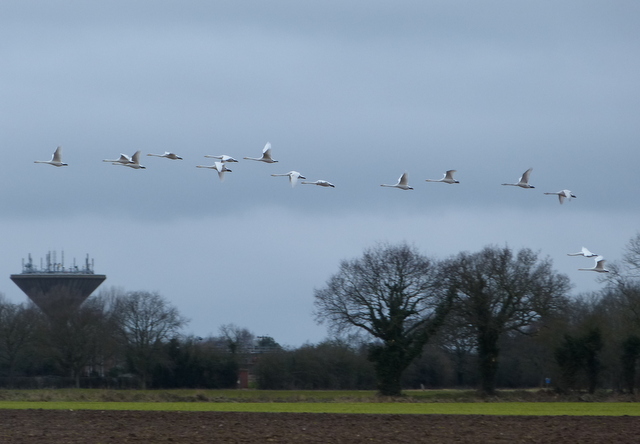 Whooper Swans – then flew off towards the levels
Whooper Swans – then flew off towards the levels
What we really wanted to see was Whooper and Bewick’s Swans together. The fact that the Whoopers had flown off towards the river, and not to another field, suggested that the big herd was not out on the old airfield. So we headed out through the village to the west to an area which the swans sometimes use. Not far beyond Ludham, we came across a ploughed field with a very large white mass in the middle, visible from some distance. We found a convenient place to stop the car and got the scopes out. The vast majority of the herd, some 200+, were Bewick’s Swans and amongst them were just a handful of Whoopers. It was great to see them alongside each other.
 Bewick’s Swans – 200+ were in the fields west of Ludham
Bewick’s Swans – 200+ were in the fields west of Ludham
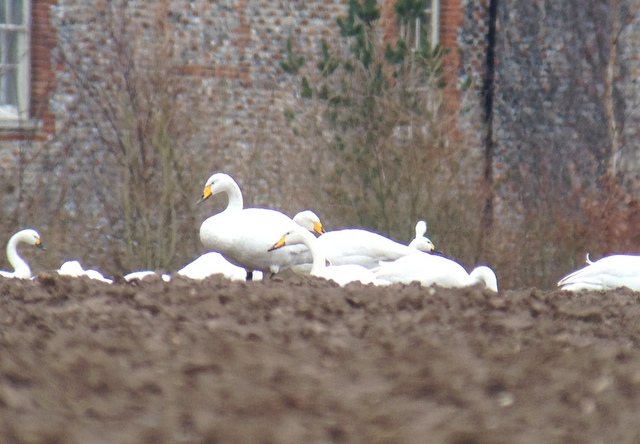 Whooper Swans – a few were amongst the Bewick’s
Whooper Swans – a few were amongst the Bewick’s
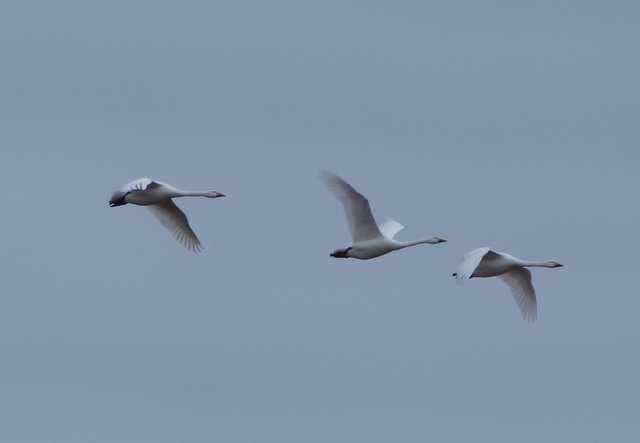 Bewick’s Swans – in flight, check out the shorter necks than the Whoopers
Bewick’s Swans – in flight, check out the shorter necks than the Whoopers
With great views of the swans in the bag, we headed over to the coast. There was an enormous flock of Pink-footed Geese, which we could see in the air as we drove, but the birds were feeding out of view from the road. The fields held large numbers of Golden Plover and Lapwing. Several Fieldfare were feeding out on the grass. A couple of Common Buzzards were standing on the telegraph poles and a number of Marsh Harriers were hunting either side of the road.
The fields in the Horsey area often hold small numbers of Common Cranes during the day, but we struggled to find them today. We picked up one Crane, but it was distant and no sooner had we turned the scopes onto it than it took off, flew a few yards and dropped down into a cover strip of tall maize. We decided on a change of plan and headed to another favoured area. We stopped the car by the road and a quick scan immediately produced two Cranes out across the fields. Finally – success. We watched them walking back and forth, feeding.
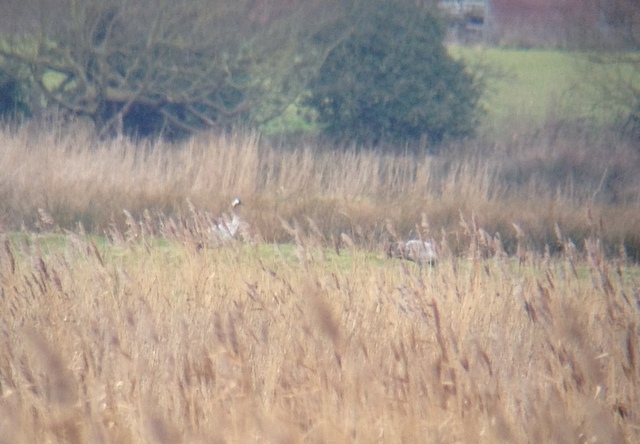 Common Cranes – two were feeding in the fields today
Common Cranes – two were feeding in the fields today
Our next stop was at Strumpshaw Fen. The feeders by the visitor centre held lots of birds – Long-tailed Tits, Coal Tits and Marsh Tits. The pool in front of Reception Hide held no more than Coot, Mallard and Gadwall. We walked out to Fen Hide – a Cetti’s Warbler was calling from deep in the scrub and a pair of Marsh Harriers was flying over the reeds. The highlight was a Chinese Water Deer, the first of many today, which emerged into one of the cut areas. However, we couldn’t find anything more interesting. The river bank was very muddy, so we headed back to the car for lunch.
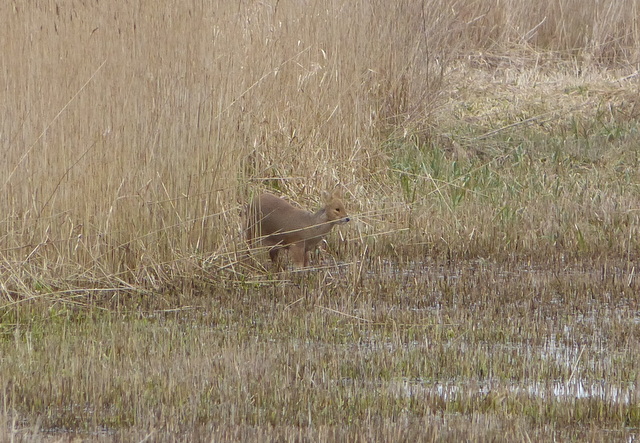 Chinese Water Deer – in the cut reeds at Strumpshaw Fen
Chinese Water Deer – in the cut reeds at Strumpshaw Fen
The Taiga Bean Geese which winter in the Yare Valley have been very hard to see this winter – they seem to have spent most of their stay somewhere else. However, two were reported again yesterday from Buckenham, so we though it was worth a quick look. Unfortunately, once again, they were nowhere to be found – in fact, Buckenham was all but devoid of geese (except for a few feral Greylag and a white ‘farmyard’ goose). However, there were more Wigeon out on the grazing marshes today, though still not as many as in previous years.
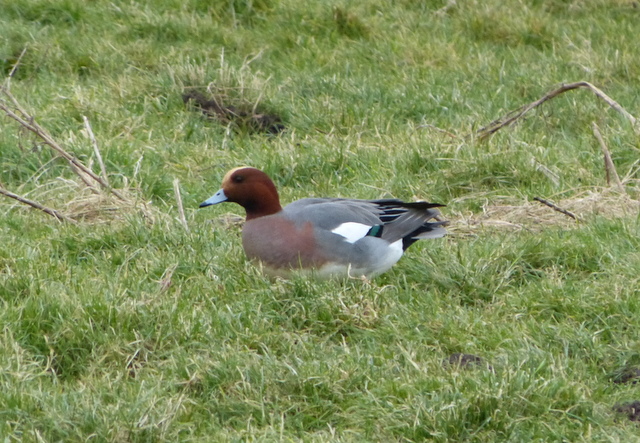 Wigeon – there were more on the marshes today
Wigeon – there were more on the marshes today
We didn’t stay and drove over to Halvergate. As we pulled off the road, before we had even stopped, we picked up a large bird with a big dark belly patch on a post nearby – the Rough-legged Buzzard. Unfortunately it took to the air just as we pulled up, but we had a fantastic view of it as it flew past close by. It spent a few minutes hovering over the grazing marshes, flashing its dark-banded white tail, before crossing the road and flying to one of its favourite posts. We got great another good look at it through the scope as it sat there.

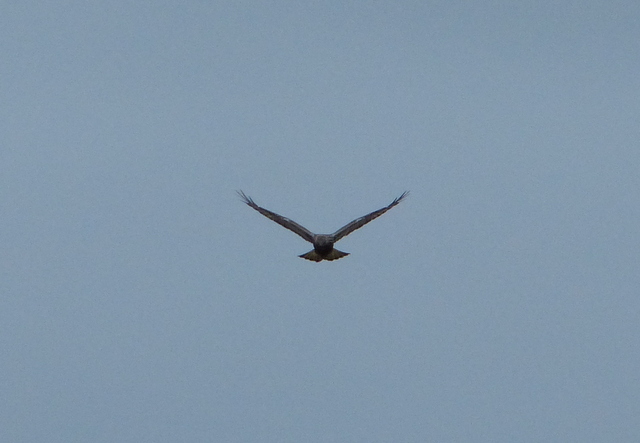 Rough-legged Buzzard – on a post and hovering over the marshes
Rough-legged Buzzard – on a post and hovering over the marshes
There are always lots of raptors at Halvergate – we picked up a female Sparrowhawk sitting low on a gate, a couple of Marsh Harriers over the reeds, including an interesting very dark juvenile with just a small white spot on the back of its nape, and a Peregrine (a lovely petite adult male!) on a gatepost. A small flock of Dunlin and lots of Lapwings were feeding around the pools in front of us. Two other waders appeared out of the wet grass behind us, calling. One was a grunting Snipe, the other was more of a surprise – the distinctive high-pitched call of a Green Sandpiper. Small numbers do spend the winter in Norfolk, often inland in farm ditches, though more head further south. This one circled overhead calling, before flying off towards the main road.
A little further along the road, a lot of white shapes out on the marshes were a mixture of Mute Swans and another group of about 40 Bewick’s Swans – interesting to see the size difference between those two. A little group of thrushes on a hawthorn bush consisted of a mixture of Fieldfare and several Redwing. With the cloud thickening and a little drizzle starting to fall, we decided to move on. We headed for our last destination of the day. On the way, another 3 Common Cranes flew up from the fields and across the road just behind us.
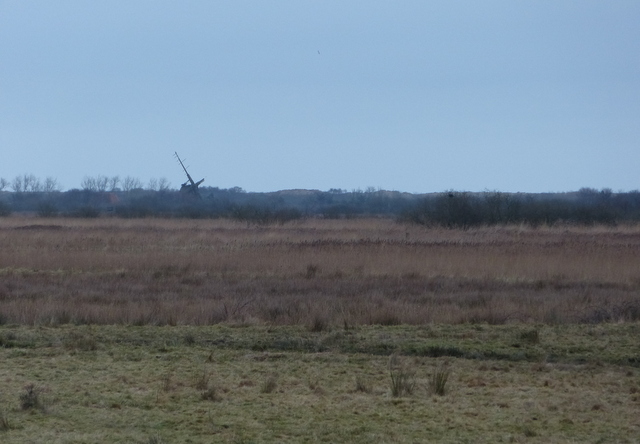 Stubb Mill – the view over the marshes from the watchpoint
Stubb Mill – the view over the marshes from the watchpoint
We arrived at Stubb Mill just after 3.30pm. It was cold and slightly damp initially, but gradually the weather improved a little. The Marsh Harriers started to drift in to the reedbed from all angles, sitting around low down in the bushes. At one point we had almost 20 circling in the air together, and still more arrived thereafter. By the end, there were at least 30 in total went into the roost, and probably many more. Then a ringtail Hen Harrier appeared, flying low across in front of us, through the bushes out over the reeds at the back, a smaller and slimmer beast altogether, flashing its white uppertail coverts. Then a second ringtail Hen Harrier flew in, closer than the first. Finally a ghostly grey male drifted in, low above the reeds, appearing and disappearing between the bushes. We watched it for some time as it circled its way through the trees. Always a majestic sight.
There are normally a couple of Common Cranes feeding out on the grass but they were nowhere to be seen at first today. Suddenly, they appeared and flew across in front of the watchpoint – a great sight. They landed on the grass out amongst the bushes and walked in to feed. As some cars drove down the road, they stretched their necks in alarm and then took off, flying off towards the reserve. A short while later, they appeared again, walking back to where they had previously been. There were other things to see here as well. A Sparrowhawk flashed across in front of us. A Kingfisher called from the depths of the ditch and flew over towards the mill. A Tawny Owl started hooting. A couple of Woodcock flew past in the gathering gloom.
That might have been the end of it, but the Cranes often leave the best ’til last. We had heard some bugling, which sounded like it was coming from birds already on the reserve. Then we heard some more bugling from somewhere to the north. Finally, as it was just getting dark, the calling picked up in intensity as they took flight. They were hard to see at first, then a long line, several small groups of these giant birds flew out of the dark. Twenty Cranes flew across in front of us, and another five flew into the glorious sunset behind us and out onto the reserve. What a great way to end the day.
















